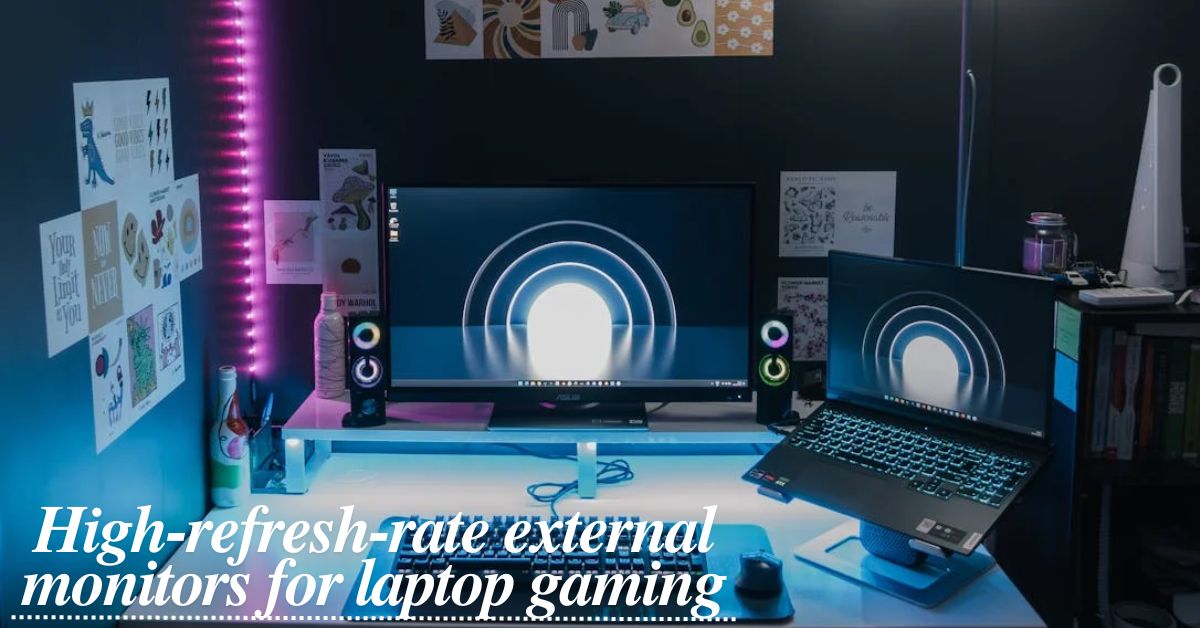High-Refresh-Rate External Monitors for Laptop Gaming

Laptop gaming has evolved significantly over the years, but one area where many gamers seek improvement is display performance. While built-in laptop screens are improving, they often lack the high refresh rates and low response times that competitive gamers demand. That’s where high-refresh-rate external monitors for laptop gaming come in. These monitors can significantly enhance your gaming experience by providing smoother visuals, reduced motion blur, and better responsiveness.
Why Choose a High-Refresh-Rate External Monitor?
1. Enhanced Smoothness and Responsiveness
High-refresh-rate monitors, typically 120Hz, 144Hz, 240Hz, or even 360Hz, allow games to run significantly smoother than standard 60Hz displays. The increased refresh rate results in a more fluid gaming experience, which is particularly beneficial for fast-paced games like first-person shooters (FPS), racing games, and esports titles.
2. Reduced Motion Blur
Motion blur can be a major issue for gamers, especially in competitive gaming scenarios. A high-refresh-rate monitor helps reduce motion blur by refreshing the display more frequently, making fast movements appear clearer and more defined.
3. Lower Input Lag
Lower input lag means quicker response times, allowing you to react faster in games. This is a crucial advantage in competitive gaming, where milliseconds can make a difference.
4. Better Visuals and Detail Clarity
Pairing a high-refresh-rate monitor with technologies like G-Sync or FreeSync helps eliminate screen tearing and stuttering, delivering seamless visuals and an overall improved gaming experience.
Key Features to Consider When Choosing a High-Refresh-Rate Monitor
1. Refresh Rate
- 120Hz – 144Hz: Ideal for most gamers who want a balance between performance and affordability.
- 240Hz – 360Hz: Best for competitive gamers looking for ultra-smooth gameplay with near-instant responsiveness.
2. Screen Size and Resolution
- 24” to 27”: Standard sizes for high-refresh-rate gaming monitors, offering a good balance between screen real estate and performance.
- 1080p (Full HD): Suitable for high-refresh-rate gaming without straining your GPU.
- 1440p (QHD): Provides a sharper image but requires a powerful GPU to maintain high frame rates.
- 4K (UHD): Not commonly found with high-refresh rates but offers exceptional visuals if your GPU can handle it.
3. Panel Type
- IPS (In-Plane Switching): Offers better color accuracy and viewing angles but can have slightly higher response times.
- TN (Twisted Nematic): Provides the fastest response times but may have inferior color accuracy and viewing angles.
- VA (Vertical Alignment): Good contrast ratios but slower response times compared to IPS and TN.
4. Adaptive Sync Technology
- G-Sync (NVIDIA): Helps prevent screen tearing and stuttering when paired with NVIDIA GPUs.
- FreeSync (AMD): Offers similar benefits for AMD GPUs.
- G-Sync Compatible: Some FreeSync monitors are also compatible with NVIDIA GPUs.
5. Connectivity Options
Ensure the monitor has the necessary ports for seamless connectivity:
- HDMI 2.0/2.1: Supports high refresh rates and resolutions.
- DisplayPort 1.4: Preferred for gaming as it supports higher refresh rates and adaptive sync technologies.
- USB-C with DisplayPort Alt Mode: Convenient for newer laptops with USB-C outputs.
Top High-Refresh-Rate External Monitors for Laptop Gaming
1. ASUS ROG Swift PG259QN
- Refresh Rate: 360Hz
- Resolution: 1080p
- Panel Type: IPS
- Adaptive Sync: G-Sync
- Why Choose It?: One of the fastest gaming monitors available, ideal for professional esports players.
2. Alienware AW2521H
- Refresh Rate: 360Hz
- Resolution: 1080p
- Panel Type: IPS
- Adaptive Sync: G-Sync
- Why Choose It?: Excellent build quality with ultra-high refresh rates for seamless competitive gaming.
3. LG UltraGear 27GN950-B
- Refresh Rate: 144Hz (Overclockable to 160Hz)
- Resolution: 4K UHD
- Panel Type: IPS
- Adaptive Sync: FreeSync Premium Pro, G-Sync Compatible
- Why Choose It?: Perfect for those who want high refresh rates and 4K gaming in one package.
4. BenQ EX2510
- Refresh Rate: 144Hz
- Resolution: 1080p
- Panel Type: IPS
- Adaptive Sync: FreeSync Premium
- Why Choose It?: Budget-friendly high-refresh-rate monitor with excellent color accuracy and HDR support.
5. Acer Predator XB273U
- Refresh Rate: 170Hz
- Resolution: 1440p
- Panel Type: IPS
- Adaptive Sync: G-Sync Compatible
- Why Choose It?: A great mid-range option for gamers wanting a balance between high refresh rates and high resolution.
Setting Up Your High-Refresh-Rate Monitor for Optimal Performance
1. Use the Right Cables
To achieve the best refresh rate, use a DisplayPort 1.4 or HDMI 2.1 cable, depending on your monitor’s specifications.
2. Adjust Refresh Rate in Settings
Go to Display Settings > Advanced Display Settings in Windows and set the monitor to its maximum refresh rate.
3. Enable Adaptive Sync
Ensure G-Sync or FreeSync is enabled for smoother gameplay without tearing or stuttering.
4. Calibrate Display Settings
Adjust brightness, contrast, and color profiles for the best visual experience.
Conclusion
Investing in a high-refresh-rate external monitor for laptop gaming can revolutionize your gameplay experience. Whether you prioritize ultra-fast refresh rates for competitive gaming or a balance between refresh rate and resolution, there are excellent options available. By considering factors like refresh rate, resolution, panel type, and adaptive sync, you can find the perfect monitor to enhance your gaming setup.
A well-chosen high-refresh-rate monitor will not only provide a smoother gaming experience but also give you a competitive edge, ensuring you stay ahead in every match. Choose wisely, optimize your settings, and enjoy unparalleled gaming performance!
Also read: Wireless gaming controllers for laptops




